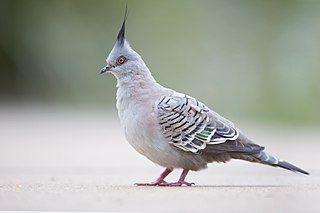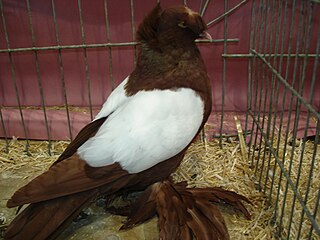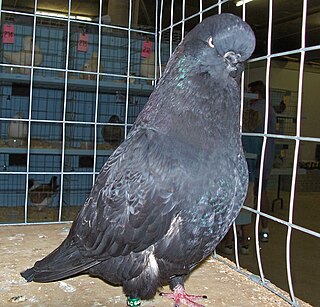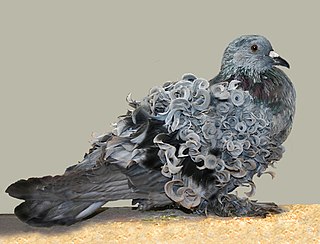
The Crested Soultz is a breed of fancy pigeon. Crested Soultz, along with other varieties of domesticated pigeons, are all descendants from the rock pigeon (Columba livia). [1]
Contents


The Crested Soultz is a breed of fancy pigeon. Crested Soultz, along with other varieties of domesticated pigeons, are all descendants from the rock pigeon (Columba livia). [1]


The crested pigeon is a bird found widely throughout mainland Australia except for the far northern tropical areas. Only two Australian pigeon species possess an erect crest, the crested pigeon and the spinifex pigeon. The crested pigeon is the larger of the two species. The crested pigeon is sometimes referred to as a topknot pigeon, a common name shared with the reddish crested Lopholaimus antarcticus of Eastern Australia.
Fancy pigeon refers to any breed of domestic pigeon, which is a domesticated form of the wild rock dove. They are bred by pigeon fanciers for various traits relating to size, shape, color, and behavior, and often exhibited at pigeon shows, fairs and other livestock exhibits.

The Fantail is a popular breed of fancy pigeon. It is characterised by a fan-shaped tail composed of 30 to 40 feathers, abnormally more than most members of the dove and pigeon family, which usually have 12 to 14 tail feathers. The breed is thought to have originated in Pakistan, India, China, Japan or Spain. There are several subvarieties, such as the English Fantail, the Indian Fantail, and the Thai Fantail. Charles Darwin used it as one of the examples in the first chapter of his book On the Origin of Species. He believed it was a descendant of the rock dove.

The domestic pigeon is a pigeon subspecies that was derived from the rock dove or rock pigeon. The rock pigeon is the world's oldest domesticated bird. Mesopotamian cuneiform tablets mention the domestication of pigeons more than 5,000 years ago, as do Egyptian hieroglyphics. Research suggests that domestication of pigeons occurred as early as 10,000 years ago.

The Dresden Trumpeter is a breed of fancy pigeon developed over many years of selective breeding.

Pigeon keeping or pigeon fancying is the art and science of breeding domestic pigeons. People have practiced pigeon keeping for at least 5,000 years and in almost every part of the world. In that time, humans have substantially altered the morphology and the behaviour of the domesticated descendants of the rock dove to suit their needs for food, aesthetic satisfaction and entertainment.

The Archangel is a breed of fancy pigeon, notable for the metallic sheen of its feathers. Archangels, along with other varieties of domesticated pigeons, are all descendants from the rock pigeon. It is kept as an ornamental or fancy breed, valued for its unusual appearance. Archangels are small, weighing about 12 oz. They have unfeathered legs and dark orange eyes. They may or may not be crested. The body of the bird is bronze or gold with wings that are either black, white, or blue.

The English Short-faced Tumbler is a breed of fancy pigeon developed over many years of selective breeding. English Short-faced Tumblers along with other varieties of domesticated pigeons are all descendants of the rock dove. The English Short-faced Tumbler is one of the oldest breeds referred to in John Moore's book Columbarium: or, The pigeon-house; being an introduction to a natural history of tame pigeons, giving an account of the several species known in England, with the method of breeding them, their distempers and cures.
The Kyiv Tumbler is a breed of fancy pigeon.

The South German Monk is a breed of fancy pigeon developed over many years of selective breeding. South German Monks, along with other varieties of domesticated pigeons, are all descendants from the rock pigeon. The South German Monk is always peak crested and clean legged or shell crested with medium length muffs blending with the hock feathers.

Utility pigeons are domesticated pigeons bred to be a source of meat called squab. Squabs have been used as a food in many nations for centuries. They were bred to breed and grow quickly. Because they are bred for squab production, conformation to a show standard is usually deemed unimportant.

The Ice pigeon is a breed of fancy pigeon developed over many years of selective breeding. Ice pigeons, along with other varieties of domesticated pigeons, are all descendants from the rock pigeon.

The English Long-faced Tumbler is a breed of fancy pigeon developed over many years of selective breeding. English Long-faced Tumblers, along with other varieties of domesticated pigeons, are all descendants of the rock dove.

The Helmet is a breed of fancy pigeon developed over many years of selective breeding. Helmets, along with other varieties of domesticated pigeons, are all descendants from the rock pigeon. The breed has medium face, short face, plain-head and crested varieties. Helmet pigeons have been referenced since the early 15th century and appear to have origins in Germany. The modern varieties were refined in the latter 20th century.

The Thuringian Colour pigeons are a group of breeds of fancy pigeons developed over many years of selective breeding. Thuringian Colour pigeons, along with other varieties of domesticated pigeons, are all descendants from the rock pigeon . The breed group is known for several different colours and markings. Varieties include the Thuringian Breast, Thuringian Monk, Thuringian Shield (picture), Thuringian Whitetail and the Thuringian Spot. The breed can be either plain or shell crested, but is always clean-legged.

The Szegedin Highflyer is a breed of fancy pigeon developed over many years of selective breeding. Szegedin Highflyers, along with other varieties of domesticated pigeons, are all descendants from the rock pigeon . The breed belongs to the Flying/Sporting pigeons group.

The Frillback is a breed of pigeon developed over many years of selective breeding. Frillbacks, along with other varieties of domesticated pigeons, are all descendants from the rock pigeon. The breed is known for the frill or curls on the wing shield feathers. The feather curl should also be present at the ends of the foot feathers or muffs.

The Danish Suabian is a breed of fancy pigeon, developed over many years of selective breeding. Danish Suabians, along with other varieties of domesticated pigeons, are all descendants from the rock pigeon . The breed comes in silver, blue, ash yellow, ash red, black, red, yellow, and brown barred and is either plain-head or peak crested.

The Lucerne Gold Collar is a breed of fancy pigeon developed over many years of selective breeding. Lucerne Gold Collars, along with other varieties of domesticated pigeons, are all descendants from the rock pigeon . The collar is required to be a rich but clear golden yellow.